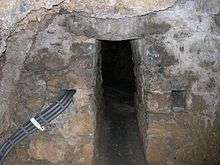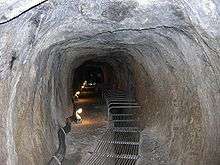Eupalinos

Eupalinos (Ancient Greek: Εὐπαλῖνος) or Eupalinus of Megara was an ancient Greek engineer who built the Tunnel of Eupalinos on Samos Island in the 6th century BC.
The tunnel, presumably completed between 550 and 530 BC,[1] is the second known tunnel in history which was excavated from both ends and the first with a methodical approach in doing so.[2] Being also the longest tunnel of its time, the Tunnel of Eupalinos is regarded as a major feat of ancient engineering. It was constructed for the tyrant Polycrates of Samos, and was a remarkable 1,036 meters (3,399 ft) long. It brought water to the city, passing through limestone at the base of a hill; this tunnel still exists.
The Greek historian Herodotus describes the tunnel briefly in his Histories (3.60) and calls Eupalinos of Megara its architect:
I have dwelt rather long on the history of the Samians because theirs are the three greatest works (ergasmata) of all the Greeks. One is a tunnel (orygma amphistomon) through the base of a nine hundred foot high mountain. The tunnel's length is seven stades, its height and length (width) both eight feet. Throughout its length another cutting (orygma) has been dug (ororyktai) three feet wide and three feet deep, through which the water flowing in pipes is led into the city from an abundant spring. The builder (architekton) of the tunnel was the Megarian Eupalinus, son of Naustrophus.
Eupalinos is supposed to be the first hydraulic engineer in history whose name has been passed down. Apart from that, though, nothing more is known about him.[3]
A large road tunnel, named after Eupalinos has been recently built under the Geraneia mountains in Corinthia, to facilitate the new expressway connection between Athens and Corinth. Eupalinos tunnel is the longest of three subsequent tunnels of the same width at this expressway.
See also
References
- ↑ Harry B. Evans, Review of Hermann Kienast, p.150
- ↑ The oldest known tunnel which was dug by two teams from opposite ends was Siloam tunnel in Jerusalem, completed around 700 BC. However, numerous false starts in wrong directions, which took the tunnel 1,500 feet (460 m) to cover a distance of 1,000 feet (300 m), indicate that the work was done without a methodical approach (Burns 173). Rather, the workers followed probably an underground watercourse (Apostel 33).
- ↑ Tom Apostel, p.33
Further reading
- Olson, Åke (2012). "How Eupalinos navigated his way through the mountain-An empirical approach to the geometry of Eupalinos". Anatolia Antiqua, Institut Français d’Études Anatoliennes. XX: 25–34.
- Apostol, Tom (2004). "The Tunnel of Samos" (PDF). Engineering and Science. 67 (1): 30–40.
- Burns, Alfred (1971). "The Tunnel of Eupalinus and the Tunnel Problem of Hero of Alexandria". Isis. 62 (2): 172–185. doi:10.1086/350729.
- Evans, Harry B. (1999). "Die Wasserleitung des Eupalinos auf Samos (Review)". American Journal of Archaeology. 103 (1): 149–150.
- Goodfield, June; Toulmin, Stephen (1965). "How Was the Tunnel of Eupalinus Aligned?". Isis. 56 (1): 46–55. doi:10.1086/349924.
- Goodfield, June (June 1964). "The Tunnel of Eupalinus". Scientific American. 210: 104–110. doi:10.1038/scientificamerican0664-104.
- Kienast, Hermann J.; Bernd Meissner (1995). Die Wasserleitung des Eupalinos auf Samos. Samos (in German). Bonn: Habelt (in Komm.). ISBN 3-7749-2713-8.
- Legon, Ronald P. (1981). Megara : the political history of a Greek city-state to 336 B.C. Ithaca, NY: Cornell University Press. ISBN 0-8014-1370-2.
- Mitchell, B. M. (1973). "Herodotus and Samos". Journal of Hellenic Studies. 95: 75–91. doi:10.2307/630871.
- Shipley, Graham (1987). A history of Samos, 800-188 BC. Oxford: Clarendon Press. ISBN 0-19-814868-2.
- Van der Waerden, B. L. (1968). "Eupalinos and His Tunnel". Isis. 59 (1): 82–83. doi:10.1086/350338.
- White, K.D. (1984). Greek and Roman technology. Ithaca, NY: Cornell University Press. ISBN 0-8014-1439-3.
External links
- Dan Hughes: The Tunnel of Eupalinos
- Tom M. Apostol: The Tunnel of Samos (HTML)
- The Eupalinian aqueduct by the Greek Ministry of Culture
